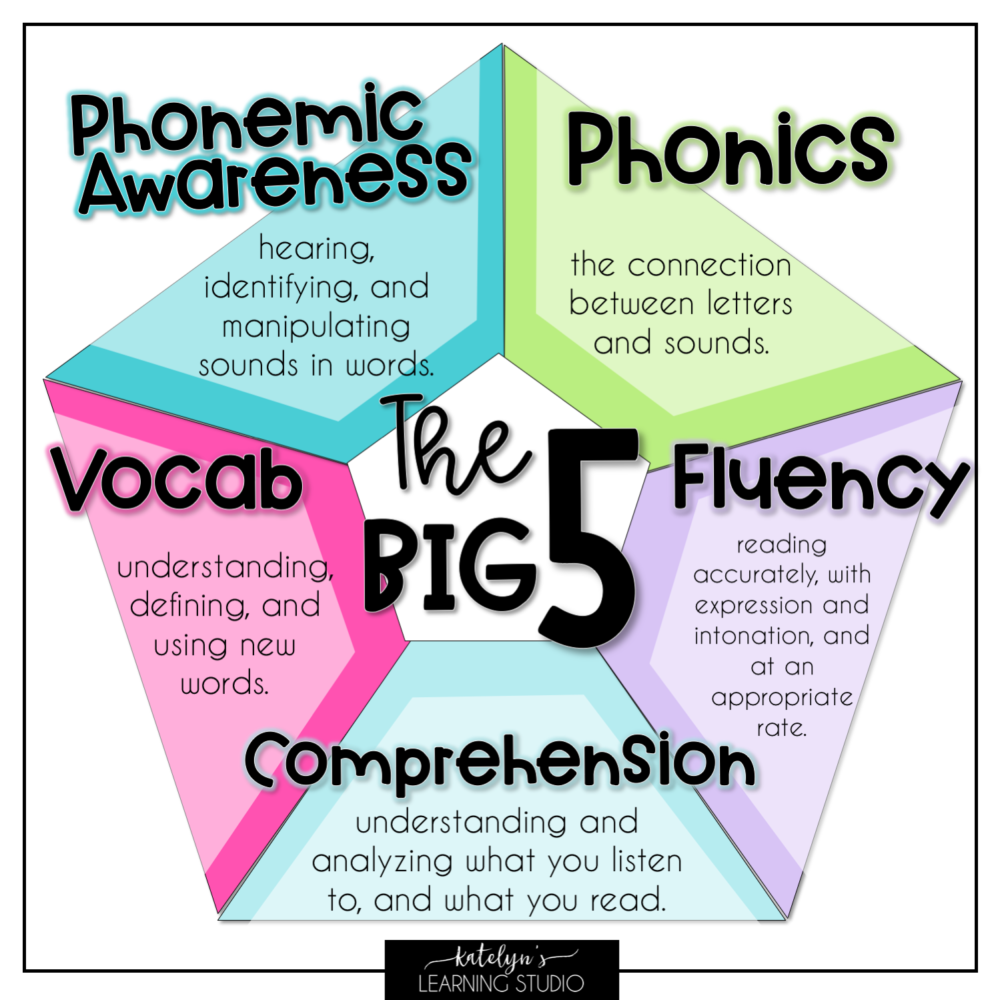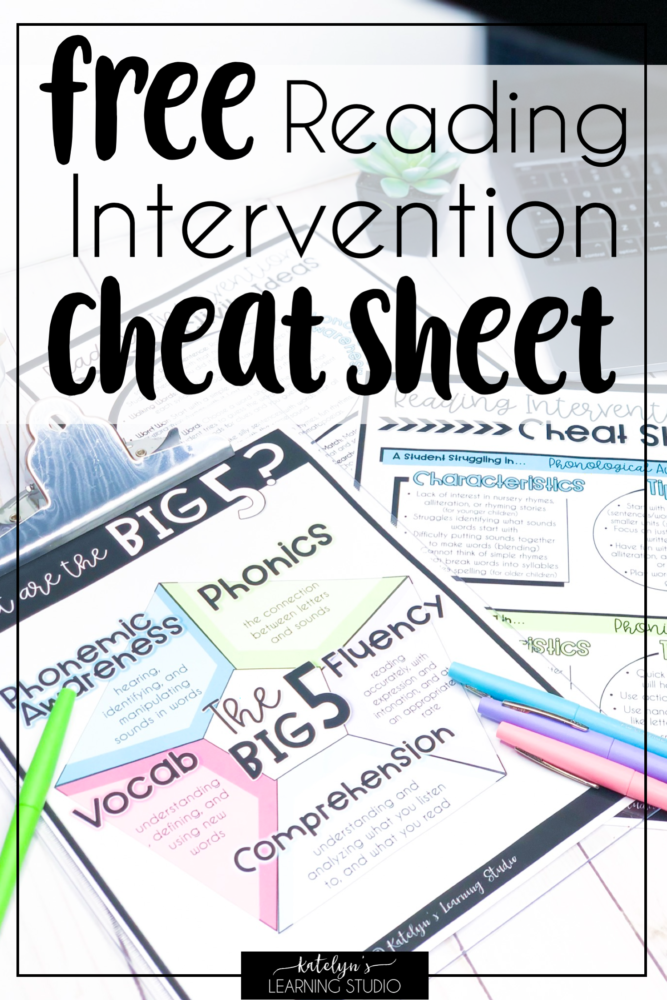Reading Skills
The Big 5 reading skills are the perfect guide for how to teach reading. Follow this reading skills list and use these strategies for reading instruction, and your students will have a solid foundation for reading success.

Strategies for reading instruction that include the Big 5 Reading Areas.
The Big 5 Reading Skills
Here are 5 more blog posts that go into detail about each specific area in the Big 5!
- What is Phonemic Awareness?
- What is Phonics?
- What is Reading Fluency?
- What is Reading Comprehension?
- What does Teaching Vocabulary Look Like?
Reading Skills Definition
Reading skills are the tools and strategies that students develop to become successful readers.
There are more components to reading than people realize. Reading is so much more than just sounding out words. There is a whole reading development continuum that needs to happen for students to build their foundation for proficient reading.
The Big 5 Reading Skills Background
In 1997, Congress asked the National Institute of Child Health and Human Development and the US Department of Education to research the most effective reading instruction strategies to teach children how to read.
They put together a panel (The National Reading Panel) that was made up of administrators, teachers, and research scientist that poured over hundreds of thousands of existing research reports on reading instruction. The panel studied the best quality research reports and put together a comprehensive recommendation for the top 5 evidence-based reading skills that are successful in teaching students how to read. The Big 5 Reading Skills is what they came up with. You can read more about the history of the National Reading Panel here.

Read about the big 5 reading skills and how they can help you give the best reading instruction.
What are the Big 5 in Reading?
Here’s a video you can watch for a visual overview of each of these Big 5 Reading Skills.
I also have this free reading skills step ladder that shows all of the steps students need to take to develop each of the Big 5 skills.
Reading Skills

The big 5 reading skills to help with your reading instruction.
The top 5 reading skills that The National Reading Panel found to be most effective in reading instruction are listed below.
Reading Skills #1: Phonemic Awareness
Phonemic Awareness: Listening to, identifying, and manipulating the sounds in words
You can read more about reading intervention strategies for phonemic awareness here.
Reading Skills #2: Phonics
Phonics: Connecting the sounds in words to printed letters and decoding words
You can read more about reading intervention strategies for phonics here.
Reading Skills #3: Fluency
Fluency: Reading with appropriate rate, accuracy, and expression
You can read more about reading intervention strategies for fluency here.
Reading Skills #4: Reading Comprehension
Reading Comprehension: Understanding and thinking about what is being read
You can read more about reading intervention strategies for comprehension here.
Reading Skills #5: Vocabulary
Vocabulary: The ability to understand and use a wide variety of words
You can read more about reading intervention strategies for vocabulary here.
Strategies for Reading Instruction
It is important to include all of the Big 5 reading skills in your reading instruction, but it can be overwhelming and confusing trying to figure out how to do that. Here are a few tips and strategies for reading instruction that can help you make sure that your students are getting help in all areas of reading they need to succeed. Also check out this Key to Stress Free Reading Intervention to help alleviate some of that overwhelm!
For more tips on how to make the most out of the reading instruction time you have, you can read this blog post on 6 Tips to Make your Reading Interventions Actually Work.
The Big 5 Reading Instruction Strategy #1:
If possible, have mini lessons for each area.
-
- You don’t need a huge long lesson for each area, each day. In fact, The National Reading Panel even reported that extensive, long lessons could even be detrimental to reading development. The most effective lessons were brief, but focused.
- These Intervention Binders have the best quick and simple activities you can do with your students that require no extra prep or extravagant planning.
The Big 5 Reading Instruction Strategy #2:
Integrate as much as possible.
-
- When students are reading, they are using all of the reading skills from each of the Big 5 areas of reading all at once. Integrating gives you more time to teach all of the reading skills, and gives them practice putting them together. For example, while teaching reading fluency, also discuss what the story is about to include reading comprehension. Use phonemic awareness to manipulate vocabulary words.
- Something to note is that even though phonemic awareness is the study of the SOUNDS of words and not written letters, phonemic awareness instruction was most effective when it included letters. It was not simply decoding and reading words, but rather using letters as a support to give students a visual as they manipulated the sounds.
The Big 5 Reading Instruction Strategy #3:
When reading a story, include all 5 Reading Skills.
-
- Instead of having a separate lesson for each area of reading, try having a lesson that revolves around a single story. It can start as a read aloud (just read the beginning of the story) and then lead into modeling of all the different skills.
- Take words from the story and model using phonemic awareness to blend words together as you sound out a word.
- Point out sight words as you read, and write them on the board.
- Discuss any new and interesting vocabulary words.
- Model and point out fluent reading.
- Stop part way through the story and practice summarizing what has happened. Have students make predictions of what they think will happen next.
- Let the students practice the reading skills as they finish reading the story on their own.
- Looking for sight words or phonics patterns they have learned in the text (they can keep a running list on the side).
- Practicing reading with fluency as they read the text out loud.
- Add interesting or new words to their list.
- Verify whether their prediction was right or wrong, and summarize the entire story when finished.
- Instead of having a separate lesson for each area of reading, try having a lesson that revolves around a single story. It can start as a read aloud (just read the beginning of the story) and then lead into modeling of all the different skills.
*Here are some of my favorite book recommendations if you are looking for books to read aloud or use in your lessons!
The Big 5 Reading Instruction Strategy #4:
Prioritize most needed aspect in guided reading (for each group), but still include all 5.
-
- Sometimes our students need more help in one area than the others. For example, lower students may need more support in phonemic awareness at the beginning, while your higher students do not need much practice in it. When doing tier 2 reading interventions or small group reading, customize your reading instruction to that group’s needs. Choose the biggest area of need and focus on that, but still include the other areas as much as possible.
- The exception to this is students who are already proficient in the lower skills (phonemic awareness, phonics, and sometimes fluency). You do not need to back track and spend time on skills that students have already mastered.
- If you need help identifying the areas your students need help in, this Comprehensive Reading Assessment can help you pinpoint exactly where they are struggling.
- Sometimes our students need more help in one area than the others. For example, lower students may need more support in phonemic awareness at the beginning, while your higher students do not need much practice in it. When doing tier 2 reading interventions or small group reading, customize your reading instruction to that group’s needs. Choose the biggest area of need and focus on that, but still include the other areas as much as possible.
These 5 areas of reading have been proven through extensive research to be the most effective reading instructional strategies to use when teaching students how to read. Helping students develop The Big 5 reading skills will best prepare them for proficient reading and success. Comment below to tell me which areas of reading you have the hardest time fitting into your teaching schedule!
If you’re interested in learning more about how to teach The Big 5 reading skills in your classroom, I have a whole blog post series you can read here on Reading Intervention Strategies for each of The Big 5 areas of reading, and a MEGA list of reading intervention activities that you can use to address a lot of these skills you can read here.
I also have a FREE Reading Intervention Cheat Sheet you can download HERE that covers each of The Big 5 Reading Skills and specific tips for how to help your students for each skill.

These reading intervention strategies and ideas will help your struggling readers!
Happy teaching and reading!


